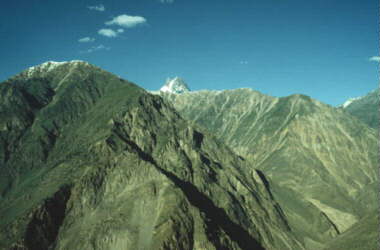Is there any significant brittle faulting on the eastern NPHM margin?
 The
eastern margin of the NPHM along the Indus section
has previously been reported [Verplanck, 1986] as the site of a suite of
large brittle faults, the Stak Fault Zone. Our observations along this
section of the eastern margin indicate that brittle faults are of minor
significance and are sparse in density, compared with the western margin
along the Indus, and farther south along the western margin. One steep
brittle fault with about 10m of gouge and near dip-slip displacement indicators
is seen near the contact, of amphibolites of Ladakh and Indian cover metasediments,
but otherwise the eastern margin appears as folded but otherwise unmodified
MMT mylonites [Photo 1; Photo
3]. Farther south near the eastern margin, between Rama and Rupal/Churit
Valleys, brittle faults with dominant dip-slip displacement indicators
occur, but are thought from the modest density, and from the absence of
a major fault at the Ladakh-Indian cover contact, to provide a minor contribution
to overall NPHM vertical displacement. We conclude, concurring with and
expanding observations of Treloar et al, 1991, that the eastern margin
of the NPHM is largely an unmodified section through the Main Mantle Thrust,
turned up by large-scale folding associated with the rise of the Nanga
Parbat antiform.
The
eastern margin of the NPHM along the Indus section
has previously been reported [Verplanck, 1986] as the site of a suite of
large brittle faults, the Stak Fault Zone. Our observations along this
section of the eastern margin indicate that brittle faults are of minor
significance and are sparse in density, compared with the western margin
along the Indus, and farther south along the western margin. One steep
brittle fault with about 10m of gouge and near dip-slip displacement indicators
is seen near the contact, of amphibolites of Ladakh and Indian cover metasediments,
but otherwise the eastern margin appears as folded but otherwise unmodified
MMT mylonites [Photo 1; Photo
3]. Farther south near the eastern margin, between Rama and Rupal/Churit
Valleys, brittle faults with dominant dip-slip displacement indicators
occur, but are thought from the modest density, and from the absence of
a major fault at the Ladakh-Indian cover contact, to provide a minor contribution
to overall NPHM vertical displacement. We conclude, concurring with and
expanding observations of Treloar et al, 1991, that the eastern margin
of the NPHM is largely an unmodified section through the Main Mantle Thrust,
turned up by large-scale folding associated with the rise of the Nanga
Parbat antiform.
Return to Abstract/Index
 The
eastern margin of the NPHM along the Indus section
has previously been reported [Verplanck, 1986] as the site of a suite of
large brittle faults, the Stak Fault Zone. Our observations along this
section of the eastern margin indicate that brittle faults are of minor
significance and are sparse in density, compared with the western margin
along the Indus, and farther south along the western margin. One steep
brittle fault with about 10m of gouge and near dip-slip displacement indicators
is seen near the contact, of amphibolites of Ladakh and Indian cover metasediments,
but otherwise the eastern margin appears as folded but otherwise unmodified
MMT mylonites [Photo 1; Photo
3]. Farther south near the eastern margin, between Rama and Rupal/Churit
Valleys, brittle faults with dominant dip-slip displacement indicators
occur, but are thought from the modest density, and from the absence of
a major fault at the Ladakh-Indian cover contact, to provide a minor contribution
to overall NPHM vertical displacement. We conclude, concurring with and
expanding observations of Treloar et al, 1991, that the eastern margin
of the NPHM is largely an unmodified section through the Main Mantle Thrust,
turned up by large-scale folding associated with the rise of the Nanga
Parbat antiform.
The
eastern margin of the NPHM along the Indus section
has previously been reported [Verplanck, 1986] as the site of a suite of
large brittle faults, the Stak Fault Zone. Our observations along this
section of the eastern margin indicate that brittle faults are of minor
significance and are sparse in density, compared with the western margin
along the Indus, and farther south along the western margin. One steep
brittle fault with about 10m of gouge and near dip-slip displacement indicators
is seen near the contact, of amphibolites of Ladakh and Indian cover metasediments,
but otherwise the eastern margin appears as folded but otherwise unmodified
MMT mylonites [Photo 1; Photo
3]. Farther south near the eastern margin, between Rama and Rupal/Churit
Valleys, brittle faults with dominant dip-slip displacement indicators
occur, but are thought from the modest density, and from the absence of
a major fault at the Ladakh-Indian cover contact, to provide a minor contribution
to overall NPHM vertical displacement. We conclude, concurring with and
expanding observations of Treloar et al, 1991, that the eastern margin
of the NPHM is largely an unmodified section through the Main Mantle Thrust,
turned up by large-scale folding associated with the rise of the Nanga
Parbat antiform.